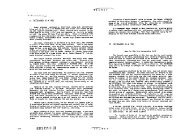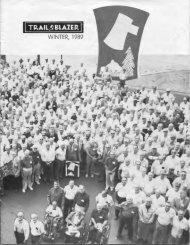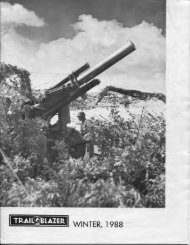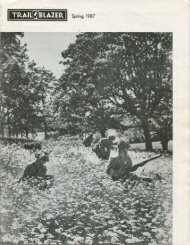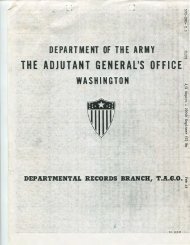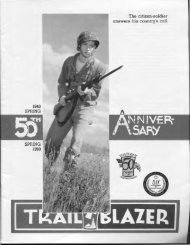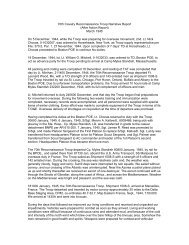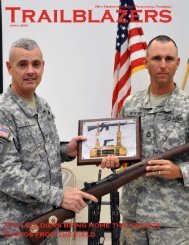Download - 70th Infantry Division Association
Download - 70th Infantry Division Association
Download - 70th Infantry Division Association
You also want an ePaper? Increase the reach of your titles
YUMPU automatically turns print PDFs into web optimized ePapers that Google loves.
This was the first and last attempt of the enemy to regain by storm the prize taken by the Bloody Axe. The<br />
swastika had been hoisted over the tower nearly five years before.<br />
But throughout the night of 19-20 February the enemy placed intense mortar and artillery fire on the<br />
castle and on all positions of the 276th overlooking Forbach.<br />
During the day of 20 February the fierce resistance continued. Attempts of the assaulting battalions to<br />
break through into the city were stopped by heavy small arms, automatic weapons, mortar and artillery<br />
fire. Our <strong>Infantry</strong>-Tank teams could not maneuver sufficiently to break up this opposition.<br />
Late in the afternoon the Third Battalion was maneuvering into the First Battalion area to assist in<br />
breaking up the small arms and automatic weapons fire holding up the advance.<br />
The Second Battalion, less G Company and elements of H, had' been released by <strong>Division</strong>, and F<br />
Company now was being employed around our right flank, while the remainder of the First Battalion<br />
contained the enemy to the front.<br />
Casualties for the period ending 1800 20 February were three killed and 63 wounded. There were also 16<br />
sick evacuated. Prisoners captured totaled 33.<br />
On 21 February the enemy, continuing a strong and determined defense of Forbach, brought in as<br />
reinforcements the First and Second Battalions of the 860th Regiment and the 14 th Company of the<br />
860th, a total of approximately 300 troops. Again on this day the backbone of the defense was heavy<br />
mortar and artillery fire, supplemented with small arms and automatic weapons. The enemy had not yet<br />
made use of air or armor.<br />
The First Battalion with F Company attached and the Third Battalion with E Company attached pushed<br />
into the city during the day and slowly but methodically cleared the southeast part of town. Because the<br />
enemy was defending with snipers and small groups of riflemen and automatic weapons units at strong<br />
points, it was a building-to-building task. For control and artillery and mortar fire direction purposes the<br />
city was divided into lettered and numbered zones.<br />
The steady advance from block to block was continuing at dark and the day's progress had brought the<br />
biggest bag of prisoners yet--100. Our losses for the period were 11 killed and 53 wounded. Eight sick<br />
also were evacuated.<br />
To facilitate the attack, the forward DP of E and C rations had been moved by S-4 from Bening to Folkling<br />
and emergency ammunition and gas DP was operating at Gaubivingen.<br />
Weather conditions throughout the attack had been generally good. Although there were early morning<br />
fogs at the outset, the days were for the most part fair and the temperature above freezing. The roads<br />
were still muddy from previous days of melting snow and rain, but their condition improving slightly with<br />
the sunshine.<br />
The night of 21 February was devoted to defending the gains made in the city. With the dawn of 22<br />
February the struggle was resumed for possession of Forbach, the enemy resisting more stubbornly than<br />
ever. The slow and painful house-to-house advance was continued with the Third Battalion on the left and<br />
the First Battalion on the right. Resistance within the city was still composed of scattered strong points,<br />
mostly in basements which served as pillboxes. Troops manning these strong points seldom gave up until<br />
they were almost completely surrounded. Heavy fire from artillery and mortars continued to fall in the<br />
sections of the city occupied by our troops. The artillery included 88's, 105's and some of even larger<br />
caliber. The defenders also used some assault guns and the small arms, automatic weapons and bazooka<br />
fire was almost continuous.<br />
The Bloody Axe continued to hack its way through this opposition throughout the day and by nightfall had<br />
reached the railroad tracks cutting through the city in a northeasterly-southwesterly direction.



